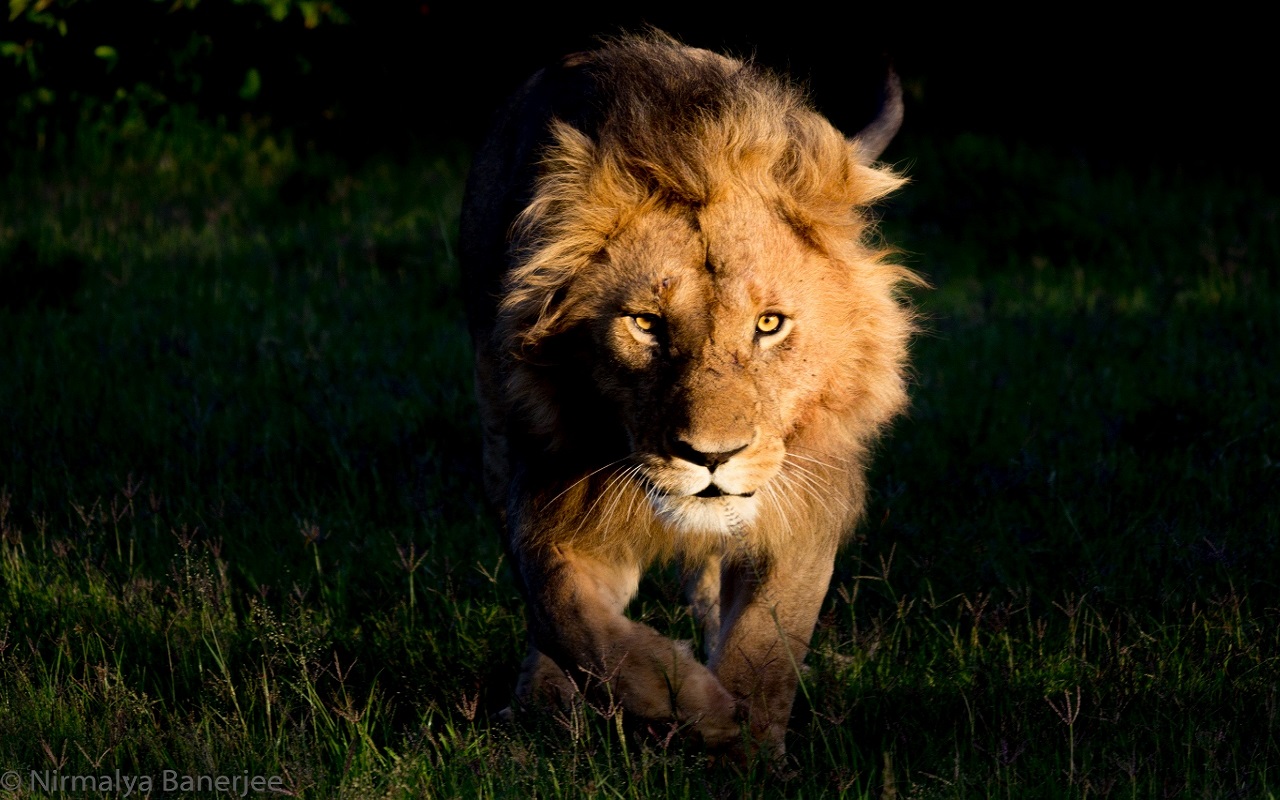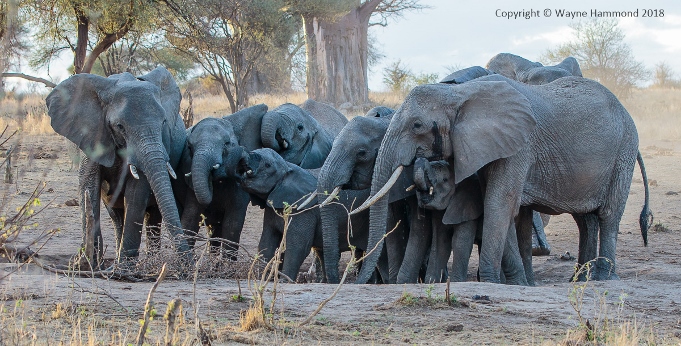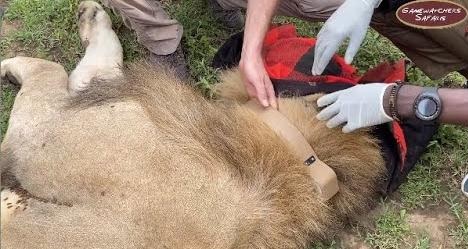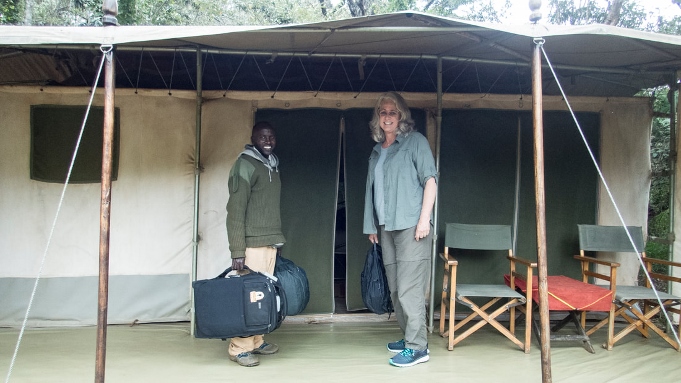
What is life like in and around a tented safari camp in a wildlife conservancy? Clinton Richardson explains …
* * * * * * * * * * * * * * * * * * * * * * * *
This series of blogs will take you on Clinton’s safari in Kenya as he travels from Atlanta (USA) to Nairobi National Park, Selenkay Conservancy (Amboseli), Ol Pejeta Conservancy (Laikipia) and Olare Motorogi Conservancy (Maasai Mara). Let’s join him on his journey as he shares his insights into the conservancies, Porini Camps and the people (and animals!) that he meets along the way. All images are from Clinton’s TrekPic.com photo site. Blog entries are from his Venture Moola blog at ReadJanus.com.
* * * * * * * * * * * * * * * * * * * * * * * *
Okay, it is only fair that you get to see the outside of a tent after last week’s image from inside. Here our guide is showing us to our tent at Nairobi National Park. It is your basic non-heated tent but with interior lights powered by the camp’s solar batteries and the other amenities we mentioned last week.
All of the tents we stay in at the four conservancies we visit will be like this one. You zip yourself in when you are there and zip yourself out when you are not. At night, you leave only with a Maasai warrior for an escort. Somehow, one always seems to be nearby when you need one. Remember, none of the camps are enclosed in any way. So animals wander through freely, especially at night.
Over the nearly two weeks we “camp” out, the grounds near our tent and the tents of our neighbors will be visited by cape buffalo, hippos, elephants, and lions making enough noise to wake some of us. This first night in Nairobi National Park, the night is full of sound. The loudest and most constant is from a pair of screaming hyenas who are close enough to camp for a ranger, dressed in her military uniform and toting a rifle, to patrol the area as we head off to our tents for the evening.
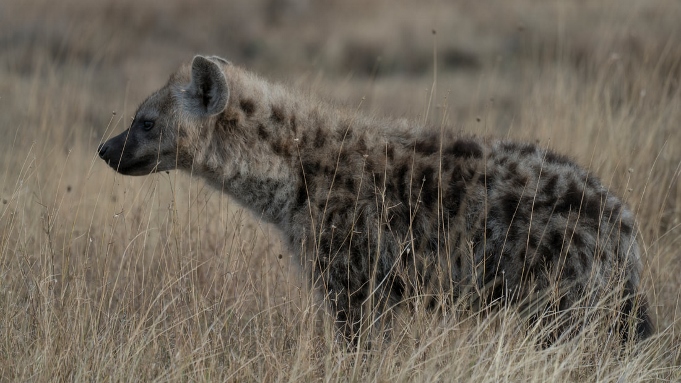
Spotted Hyena
The next morning Frances was eager to speak with our host about the sounds the night before and about the armed guard. Was she here to protect us from bandits or was it a precaution because of the hyenas? The thought of marauding bandits had unsettled her.
Our host laughed when he heard the question. “No” he said. “No one worries about bandits in the night. You’d have to be crazy to wander around here at night. With the hyenas, lions and hippos around, something would surely get you.” The guard had been called in because of the proximity of the hyenas.
Somehow, this was reassuring. After all, we were zipped into our tents at night and we were escorted when we out after dark.
Our concerns addressed, we headed to the mess tent for breakfast and got ready for the morning game drive. We would be driving with a couple from Hong Kong and another from Toronto. All of us are first time safari goers so the mood is upbeat and expectant. They were with us for the afternoon drive the day before when we had good sightings of zebra and white rhino so we have reason to be optimistic.

Juvenile White Rhino
It was early, as it always would be before morning drives. Up at 5:45 when coffee and biscuits are delivered to the tent, a hot breakfast in the mess tent, and then off in our safari vehicle by 6:30. Before we were 200 yards out of the camp we spot a lion in the grass, one of the contributors to last night’s serenade. Later we get up close with a pair of white rhinos, mother and child. It is surprising how close the vehicles come to the rhino and how totally unconcerned they appear to be with our presence.
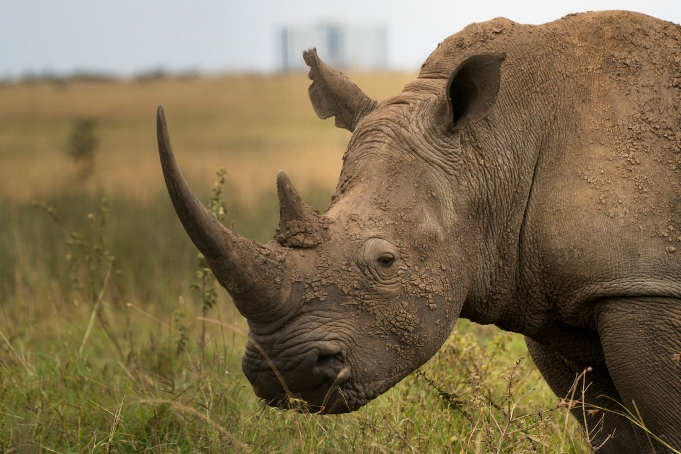
Mud Encrusted Adult Female White Rhino
This sighting is followed by sightings of hartebeast, warthogs, gazelles, ostrich and a pair of jackals who run off when our vehicle approaches and, at least when they flee, look much like American foxes. It is a short drive this morning which gets us back by 10:00 before we head out to see the nearby David Sheldrick Elephant Orphanage.
It is a short drive to the orphanage where we gather with a crowd of hundreds of locals and tourists around a roped off area of open dirt. Several handlers dressed in green lab coats and white hats wait patiently while a host of six to eight baby elephants approach in a line toward the open area. They move quickly, knowing they will receive bottles of milk from their handlers. We watch the feeding and play that follows until they are led off and another, slightly older, group of young elephants comes to feed.

Our driver and Maasia guide were excited to visit the elephant refuge. The animals are revered for their imposing size, intellect and gentle family ways. “Elees” we call them, is what John or guide told us as we walked into the refuge.
We return to camp for a 1:00 lunch and then a 4:00 afternoon ride. As we make our first turn out of the camp we are forced to stop. Dozens upon dozens of baboons are walking down the road toward us. The leaders in the front of the group move off into the woods to our right before they reach our vehicle but, again, their is no show of concern from any member of the troop.
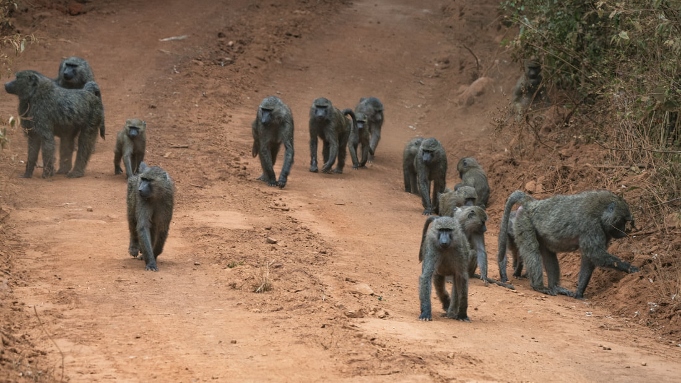
As we sit an watch, wave upon wave of baboons make their way down the dirt road, stopping here and their to inspect the ground, the bush or each other. They are in no hurry. As they get close to our vehicle, they follow the leaders into the brush. Eventually they are gone, invisible to us in the brush, and we make our way up the road.
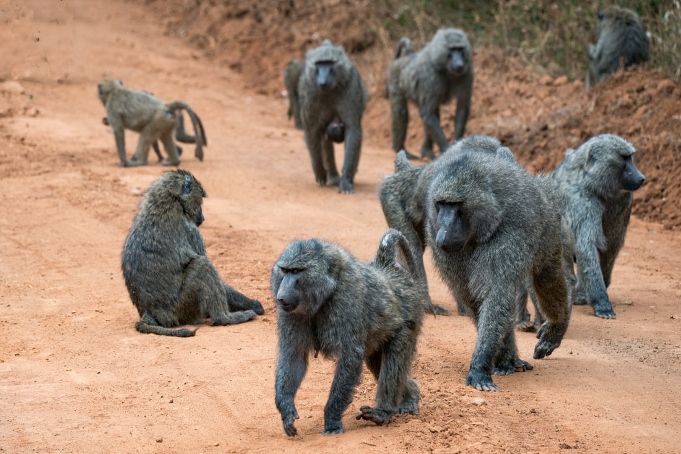
The rest of the drive yields viewings of cape buffalo coming out of the woods into the grasslands and later, in a herd, blocking the dirt roadway. We also spot a serval cat in the roadway who disappears quickly into the tall grass as our vehicle approaches. And, we see our first kill remains. Bleached bones beside the road.
We return to camp before sunset, which occurs near 7:00 every day. After cleaning up, we gather around a fire in lawn chairs to share stories from our day and to get to know one another.
Before dinner, a new couple joins our group from Sydney. They are expatriates from South Africa, leaving there for Melbourne “to give our kids opportunities for a better life” after the chaos that followed the end of apartheid. They were active in the progressive movement, he says, and sorely disappointed wen the ruling white minority did not affirmatively plan for the change to majority rule.
More next time as we get to know our travel mates better, explore more of Nairobi National Park and head by small plane to the Maasai Selenkay Conservancy near Amboseli National Park.
First published 11 Oct 2018. All photos and text are © Clinton Richardson. All images are from his galleries at TrekPic.com
About Clinton Richardson
Clinton Richardson has been writing and taking photographs for decades. His books include the critically acclaimed 5th edition Richardson’s Growth Company Guide 5.0 and the award-winning book about social media and ancient coins called Ancient Selfies. His images, including images taken on his trip, can be viewed at TrekPic.com. His Venture Moola blog can be viewed at Readjanus.com.
See Other Blogs in this Series:
- Safari Countdown: Prepping for Kenya
- Safari 1: The Hunt
- Safari 2: Off to Nairobi
- Safari 4: Passports In His Underpants
- Safari 5: Night Lions to Amboseli
- Safari 6: Amboseli to Selenkay
- Safari 7: Pooh On You
- Safari 8: Eaten by a Lion?
- Safari 9: The Maasai
- Safari 10: On the Move
- Safari 11: Crash on the Grass
- Safari 12: Sundowner Surprise
- Safari 13: Stalag Panzee
- Safari 14: Bump in the Night
- Safari 15: Dry Season Showers
- Safari 16: How Many Wives Would You Like to Have?
- Safari 17: Distracting His Highness
- Safari 18: How to Eat a Tree
- Safari 19: Hunting with Children (well, cubs!)
- Safari 20: Blue Jean Symphony
- Safari 21: African Nights
on Friday 02nd November 2018 at 09:54



